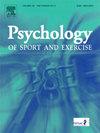竞技女性钢管舞者身体意象的质性研究
IF 3.3
2区 心理学
Q2 HOSPITALITY, LEISURE, SPORT & TOURISM
引用次数: 0
摘要
一项新兴的研究表明,休闲钢管舞通过归属感、身体多样性和自由的性表达来提升身体自信。然而,尚不清楚这些积极的经验是否会延伸到竞争激烈的环境中。对运动员的研究表明,竞争环境往往会促进对运动员身体的严格期望,身体比较和自我物化。这些身体上的不安全感会在比赛结束后持续存在。目前的研究旨在通过探索竞争性钢管舞如何影响女性在竞争环境中对自己身体的看法来解决这一差距。参与者(N = 20名女性)通过电子邮件和传单被招募到澳大利亚的钢管舞工作室和活动组织者,参加半结构化的面试。使用反身性主题分析,我们构建了三个主题:(i)身体功能是最重要的;社区为归属感提供滋养和紧张;通过自治赋予权力。虽然竞争环境提供了比较和不安全感的机会,但优先考虑通过功能方式观察和欣赏自己身体的能力,使女性在竞争中和竞争之外都能对自己的身体产生积极的看法。这一发现让我们更深入地了解了影响钢管舞者身体形象的独特因素,为在竞争和社会环境中有益于女性身体形象的训练方案和干预措施提供了策略。本文章由计算机程序翻译,如有差异,请以英文原文为准。
A qualitative study of body image among competitive women pole dancers
An emerging literature suggests that recreational pole dancing promotes body confidence via a sense of belonging, body diversity, and free sexual expression. However, it's unclear whether these positive experiences extend to competitive pole contexts. Research among athletes suggests that competitive environments often promote rigid expectations of athletic bodies, body comparisons, and self-objectification. These body insecurities can persist beyond competition. The current study aims to address this gap by exploring how competitive pole dancing contributes to women's perceptions of their bodies in and out of competitive environments. Participants (N = 20 women) were recruited via emails and flyers disseminated across pole studios and event organizers in Australia to participate in semi-structured interviews. Using reflexive thematic analysis, we constructed three themes: (i) Body functionality is paramount; (ii) Community provides nurturance and tensions for belonging; (iii) Empowerment through autonomy. Although competitive environments provided opportunities for comparison and insecurities, prioritizing the ability to view and appreciate one's body primarily through a functional manner allowed women to achieve positive perceptions of their bodies in and out of competition. The findings provide a deeper understanding of the factors uniquely contributing to body image in a novel sample of pole dancers, offering strategies for training regimens and interventions that may benefit women's body image in competitive and social contexts.
求助全文
通过发布文献求助,成功后即可免费获取论文全文。
去求助
来源期刊
CiteScore
6.40
自引率
5.90%
发文量
172
审稿时长
69 days
期刊介绍:
Psychology of Sport and Exercise is an international forum for scholarly reports in the psychology of sport and exercise, broadly defined. The journal is open to the use of diverse methodological approaches. Manuscripts that will be considered for publication will present results from high quality empirical research, systematic reviews, meta-analyses, commentaries concerning already published PSE papers or topics of general interest for PSE readers, protocol papers for trials, and reports of professional practice (which will need to demonstrate academic rigour and go beyond mere description). The CONSORT guidelines consort-statement need to be followed for protocol papers for trials; authors should present a flow diagramme and attach with their cover letter the CONSORT checklist. For meta-analysis, the PRISMA prisma-statement guidelines should be followed; authors should present a flow diagramme and attach with their cover letter the PRISMA checklist. For systematic reviews it is recommended that the PRISMA guidelines are followed, although it is not compulsory. Authors interested in submitting replications of published studies need to contact the Editors-in-Chief before they start their replication. We are not interested in manuscripts that aim to test the psychometric properties of an existing scale from English to another language, unless new validation methods are used which address previously unanswered research questions.

 求助内容:
求助内容: 应助结果提醒方式:
应助结果提醒方式:


